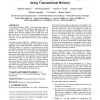Free Online Productivity Tools
i2Speak
i2Symbol
i2OCR
iTex2Img
iWeb2Print
iWeb2Shot
i2Type
iPdf2Split
iPdf2Merge
i2Bopomofo
i2Arabic
i2Style
i2Image
i2PDF
iLatex2Rtf
Sci2ools
ICS
2009
Tsinghua U.
2009
Tsinghua U.
QuakeTM: parallelizing a complex sequential application using transactional memory
“Is transactional memory useful?” is the question that cannot be answered until we provide substantial applications that can evaluate its capabilities. While existing TM applications can partially answer the above question, and are useful in the sense that they provide a first-order TM experimentation framework, they serve only as a proof of concept and fail to make a conclusive case for wide adoption by the general computing community. This paper presents QuakeTM, a multiplayer game server; a complex real life TM application that was parallelized from the sequential version with TM-specific considerations in mind. QuakeTM consists of 27,600 lines of code spread across 49 files and exhibits irregular parallelism for which a task parallel model fits well. We provide a coarse-grained TM implementation characterized with eight large transactional blocks as well as a fine-grained implementation which consists of 58 different critical sections and compare these two approaches. In spite...
Coarse-grained Tm Implementation | ICS 2009 | Theoretical Computer Science | Tm Application | Transactional Memory |
| Added | 20 May 2010 |
| Updated | 20 May 2010 |
| Type | Conference |
| Year | 2009 |
| Where | ICS |
| Authors | Vladimir Gajinov, Ferad Zyulkyarov, Osman S. Unsal, Adrián Cristal, Eduard Ayguadé, Tim Harris, Mateo Valero |
Comments (0)

